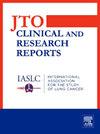A Phase I Dose-Escalation Clinical Trial of Bronchoscopic Cryoimmunotherapy in Advanced-Stage NSCLC
IF 3.5
Q2 ONCOLOGY
引用次数: 0
Abstract
Introduction
Outcomes for NSCLC remain suboptimal. Recent data suggest that cryoablation can generate antitumor immune effects. In this first-in-human phase I clinical trial, we investigated the safety and feasibility of bronchoscopic cryoimmunotherapy (BCI) delivered during standard-of-care bronchoscopy and explored associated systemic immune responses.
Methods
Subjects with known or suspected advanced-stage NSCLC were recruited. BCI was delivered in dose-escalated freeze-thaw cycles to determine maximum dose tolerance. Feasibility assessment was determined with a pre-set goal of achieving successful BCI in more than or equal to 80% of subjects. Safety was assessed by review of BCI-related complications, including grades 2 to 3 bleeding, pneumothorax requiring intervention, and National Cancer Institute Common Terminology Criteria for Adverse Events grade 3 to 5 adverse events. Pre- and post-BCI blood samples were collected to explore changes in the systemic immune profile.
Results
Subjects with predominantly clinical TNM stage 3 or 4 adenocarcinoma or squamous cell carcinoma were enrolled. We reached the maximum dose of 30 seconds with 100% feasibility and no BCI-related adverse events. In peripheral blood analysis, we observed a significant decrease in derived neutrophil-to-lymphocyte ratio in the high-dose BCI group in comparison to the low-dose BCI cohort. We also observed increases in inflammatory cytokines—GM-CSF, IFN-γ, IL-1β, IL-17A, and IL-2—and effector memory T cells post-BCI.
Conclusion
BCI is safe and feasible. In addition, we provide preliminary evidence that at higher dose levels there is a systemic immune response consistent with a cytotoxic profile. Further immune analyses will determine the potential of BCI as an adjunctive therapy in combination with immune checkpoint inhibition in NSCLC treatment.
支气管镜下低温免疫治疗晚期NSCLC的I期剂量递增临床试验
NSCLC的预后仍然不理想。最近的研究表明,冷冻消融术可以产生抗肿瘤的免疫作用。在这项首次人体I期临床试验中,我们调查了在标准支气管镜检查期间进行支气管镜冷冻免疫治疗(BCI)的安全性和可行性,并探讨了相关的全身免疫反应。方法招募已知或疑似晚期非小细胞肺癌的受试者。BCI以剂量递增的冻融循环递送,以确定最大剂量耐受。可行性评估确定了一个预先设定的目标,即在超过或等于80%的受试者中实现成功的脑机接口。安全性通过bci相关并发症评估,包括2 - 3级出血、需要干预的气胸,以及国家癌症研究所不良事件通用术语标准3 - 5级不良事件。收集脑损伤前和脑损伤后的血液样本,以探讨全身免疫谱的变化。结果研究对象主要为临床TNM 3期或4期腺癌或鳞状细胞癌。我们达到了30秒的最大剂量,100%的可行性,没有脑接口相关的不良事件。在外周血分析中,我们观察到与低剂量BCI组相比,高剂量BCI组衍生中性粒细胞与淋巴细胞比率显著降低。我们还观察到脑损伤后炎症细胞因子- gm - csf、IFN-γ、IL-1β、IL-17A和il -2以及效应记忆T细胞的增加。结论脑机接口是安全可行的。此外,我们提供的初步证据表明,在较高剂量水平下,存在与细胞毒性相符的全身免疫反应。进一步的免疫分析将确定BCI与免疫检查点抑制联合作为非小细胞肺癌治疗辅助疗法的潜力。
本文章由计算机程序翻译,如有差异,请以英文原文为准。
求助全文
约1分钟内获得全文
求助全文
来源期刊

JTO Clinical and Research Reports
Medicine-Oncology
CiteScore
4.20
自引率
0.00%
发文量
145
审稿时长
19 weeks
 求助内容:
求助内容: 应助结果提醒方式:
应助结果提醒方式:


